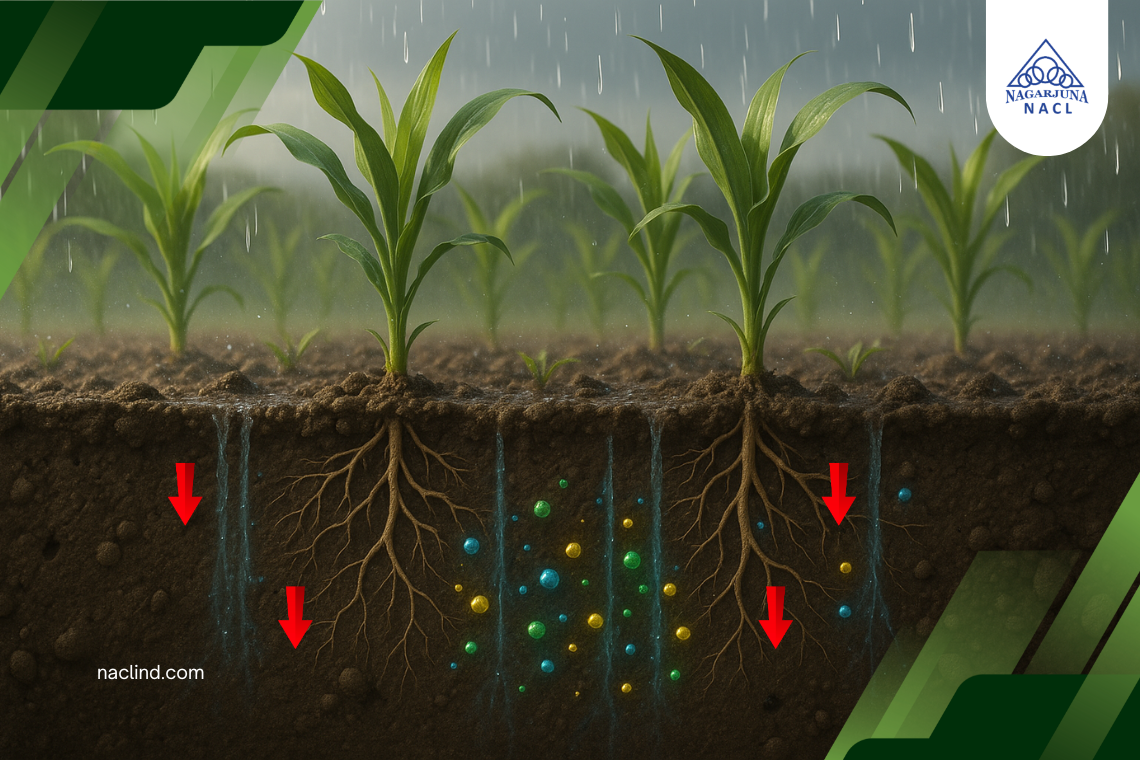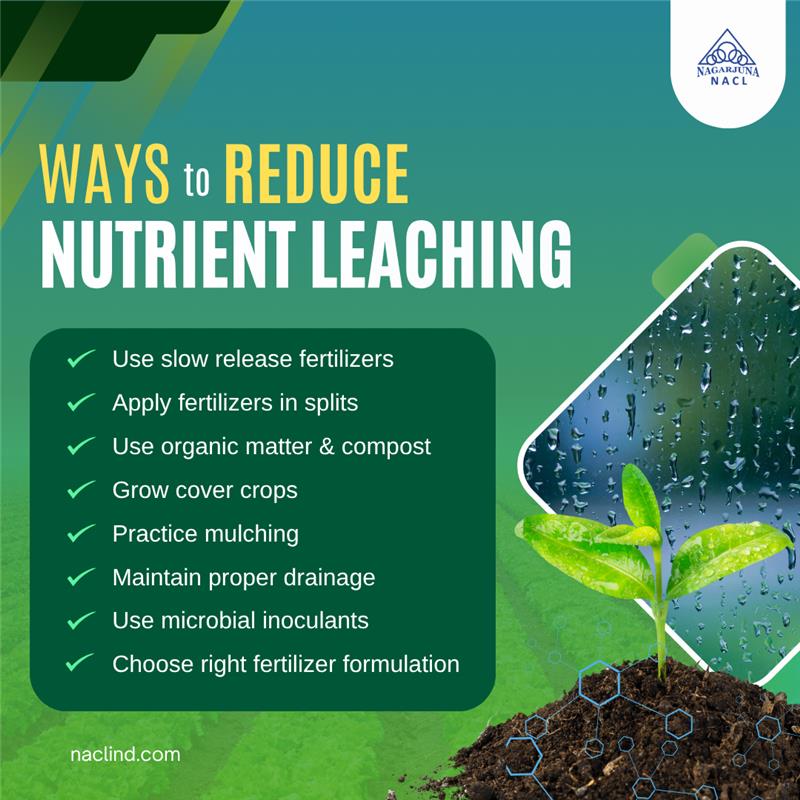
How to Tackle Nutrient Leaching in Monsoon Rains
The monsoon season brings life to our fields, replenishing the water tables while also supporting healthy crops. However, it also brings a hidden challenge for farmers- nutrient leaching.
Heavy rains often wash away essential nutrients such as Nitrogen, Potassium, and Sulphur from the root zone, leaving the soil depleted and crops undernourished. Over time, this can result in lower yields, poor soil structure, and increased input costs and pollute the ground water resources.
Understanding how to prevent and manage nutrient leaching during the monsoon is crucial for every farmer. To maintain productivity and profitability, farmers must adopt smart, sustainable methods from soil management to the right Agrochemical solutions — that can effectively tackle nutrient leaching during the monsoon. Let’s explore what causes it and the practical ways to minimize its impact.
What Is Nutrient Leaching?
Nutrient leaching occurs when water moves downward through the soil, carrying soluble nutrients beyond the reach of plant roots. During monsoon rains, excessive water percolation accelerates this process. Nutrients like nitrate-nitrogen are especially prone to leaching because they dissolve easily and move quickly with rainwater.
Other nutrients, such as Potassium, Sulphur, and Magnesium, can also be leached from sandy or light-textured soils with low water-holding capacity. Once these nutrients move below the root zone, they become unavailable to plants and can even contaminate groundwater.
Why Is Leaching More Severe During Monsoons?
Several factors make the monsoon season a critical time for leaching:
- High Rainfall Intensity: Continuous heavy rains saturate the soil and increase downward flow of water flow, pushing the nutrients deeper into the soil.
- Sandy or Loamy Soils: Such soils drain quickly, leading to faster nutrient loss than clayey soils.
- Unbalanced Fertilizer Application: Applying fertilizers without considering soil type or weather can lead to increased losses.
- Poor Soil Organic Matter: Soils lacking organic carbon have lower the nutrient-holding capacity.
- No Protective Cover: Bare fields during monsoon storms are more prone to runoff and nutrient loss.
Understanding these causes helps farmers design better soil and nutrient management plans.
Visible Effects of Nutrient Leaching on Crops
Nutrient leaching doesn’t always show immediate symptoms, but its effects are noticeable over time. Common signs include:
- Yellowing leaves, especially lower leaves, are due to nitrogen deficiency.
- Stunted growth and weak plant structure.
- Reduced tillering in cereals and poor fruit set in vegetables.
- Lower yield and grain quality deterioration.
By the time the symptoms appear, significant damage might already have occurred beneath the soil surface. Therefore, preventive action is key.

Practical Ways to Reduce Nutrient Leaching
Farmers can take several sustainable steps to minimize the nutrient loss during monsoon rains. Let’s look at some of the most effective approaches:
1. Use Slow-Release or Controlled-Release Fertilizers
Slow-release fertilizers gradually release nutrients in synchronisation with the crop demand. This reduces the risk of leaching, especially nitrogen-based fertilizers. Polymer-coated urea or sulphur-coated urea are good options during the rainy season. They ensure a steady supply of nitrogen without excessive loss through runoff or percolation.
2. Apply Fertilizers in Splits
Instead of applying the full dose of fertilizer at once, divide it into smaller, timed applications based on crop growth stages. About 40–50% of total Nitrogen requirement is to be given as basal dose at sowing/ planting/ final land preparation, then give the remaining 50–60% in 1–2 top dressings — first at early vegetative stage and second at tillering/flower initiation depending on crop and soil. This approach reduces the amount of free nitrogen in the soil at any one time, limiting leaching losses.
With the right combination of crop protection solutions and scientific nutrient planning, farmers can protect their soil, boost crop yield, and ensure long-term farm sustainability.
3. Incorporate Organic Matter and Compost
Organic matter acts like a sponge, holding nutrients and water within the soil. Incorporating farmyard manure, compost, or green manure improves soil structure and increases its nutrient-holding capacity. Organic carbon also promotes microbial activity, which helps recycle and retain the nutrients.
4. Grow Cover Crops
Cover crops such as legumes, cowpea, or Sunn hemp protect the soil surface during heavy rains. They reduce runoff and erosion while absorbing excess nutrients that would otherwise be lost. Once the rain subsides, these cover crops can be used into the soil as green manure, further enriching its fertility.
5. Practice Mulching
Applying mulch — whether crop residues, straw, or organic waste — helps reduce the direct impact of raindrops on the soil surface. Mulching slows down water infiltration and minimizes surface runoff. It also improves moisture retention and stabilizes soil temperatures, supporting microbial activity and nutrient availability.
6. Maintain Proper Drainage
Water stagnation is as harmful as excessive drainage. Installing contour bunds, grassed waterways, or small check dams can help manage water flow. Proper drainage ensures that rainwater doesn’t wash away topsoil or fertilizers while allowing enough infiltration for roots to access nutrients.
7. Use Biofertilizers and Microbial Inoculants
Microbial inoculants such as Azospirillum, Rhizobium, or phosphate-solubilizing bacteria can help plants absorb nutrients more efficiently. These beneficial microbes enhance soil health and reduce dependency on synthetic fertilizers, indirectly minimizing nutrient leaching.
8. Choose the Right Fertilizer Formulation
Selecting fertilizers that match the soil type and crop needs is critical. For instance, ammonium-based fertilizers are less prone to leaching than nitrate-based fertilizers. Similarly, granular or coated fertilizers tend to remain longer in the soil than liquid forms during heavy rains.
9. Soil Testing and Nutrient Planning
Before every season, conduct a soil test to understand nutrient levels, pH, and texture. This helps in applying fertilizers more accurately. Balanced fertilization ensures that no single nutrient is applied in excess, thereby reducing the risk of leaching.
10. Conservation Agriculture Practices
Adopting the conservation practices such as minimum tillage, crop rotation, and intercropping improve not only the soil structure while reducing erosion, but also enhances nutrient use efficiency. These methods also build long-term soil resilience against monsoon-induced nutrient losses.
Conclusion
Monsoon rains are a blessing, but without careful soil and nutrient management, they can turn into a challenge. Tackling nutrient leaching requires a mix of smart soil management, modern Agrochemical solutions, and sustainable practices like mulching, cover cropping, and organic amendments.
By choosing top agrochemical solutions in India that focus on nutrient efficiency and environmental safety, every farmer can turn the monsoon season into a time of renewal — not risk.

